Yoga offers powerful relief for anxiety and depression through mindful practices that combine physical postures, breathing techniques, and meditation. You'll experience reduced stress, improved mood regulation, and enhanced emotional balance. Regular practice decreases cortisol levels and increases GABA production, alleviating symptoms of anxiety and depression. Gentle Hatha yoga, restorative practices, and specific poses like Sun Salutations can energize or calm your mind and body. By incorporating breathwork and mindfulness, you'll develop better self-awareness and resilience. Yoga's neurological benefits rewire your brain for improved mental health, making it an effective complementary approach to therapy. Discover how this ancient practice can transform your mental well-being.
Key Takeaways
- Yoga reduces stress and promotes relaxation through physical postures and meditation, decreasing cortisol levels and alleviating symptoms of anxiety and depression.
- Regular yoga practice increases GABA production, enhancing mood regulation and improving emotional self-awareness.
- Gentle Hatha Yoga and Restorative Yoga practices are particularly effective for anxiety relief, fostering mindfulness and activating the parasympathetic nervous system.
- Energizing poses like Sun Salutations and Warrior Poses combat depression by building confidence and vitality.
- Integrating mindfulness and meditation with yoga amplifies mental health benefits, reducing rumination and enhancing overall resilience.
Understanding Yoga's Mental Health Benefits
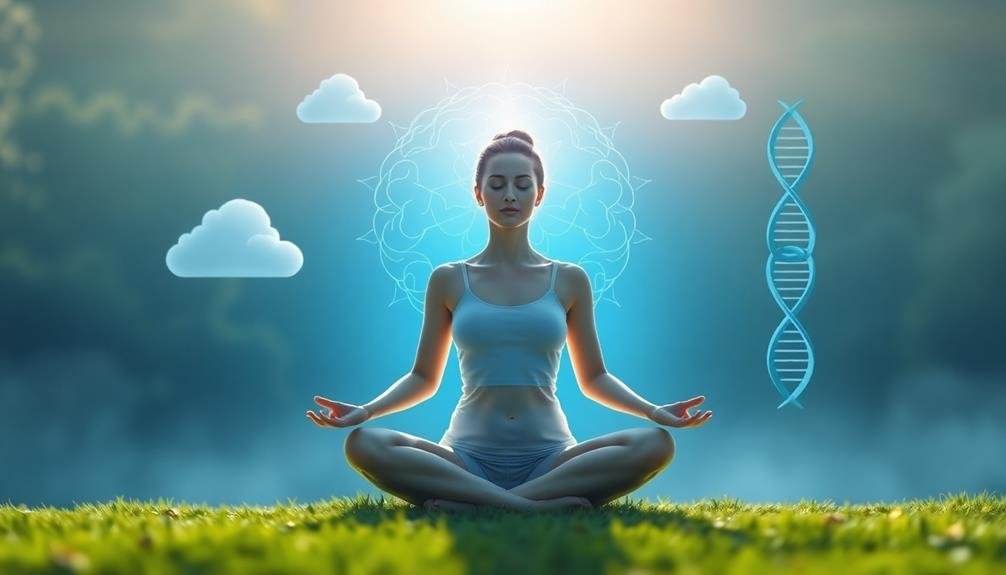
In light of increasing mental health concerns, yoga has emerged as a powerful tool for managing anxiety and depression. This ancient practice combines physical postures, breathing exercises, and meditation to promote overall well-being. When you engage in yoga regularly, you're not just stretching your body; you're also cultivating a mindful connection between your physical and mental states.
Yoga's mental health benefits stem from its ability to reduce stress and promote relaxation. As you practice, you'll notice a decrease in cortisol levels, the hormone responsible for stress. This reduction can help alleviate symptoms of anxiety and depression.
Additionally, yoga increases the production of gamma-aminobutyric acid (GABA), a neurotransmitter that helps regulate mood and promotes calmness.
The mindfulness aspect of yoga teaches you to stay present and observe your thoughts without judgment. This skill can be particularly beneficial for those struggling with anxiety or depression, as it helps break the cycle of negative thinking.
Through consistent practice, you'll develop better emotional regulation, improved self-awareness, and a greater sense of inner peace. These benefits extend beyond the yoga mat, positively impacting your daily life and overall mental health.
Types of Yoga for Anxiety
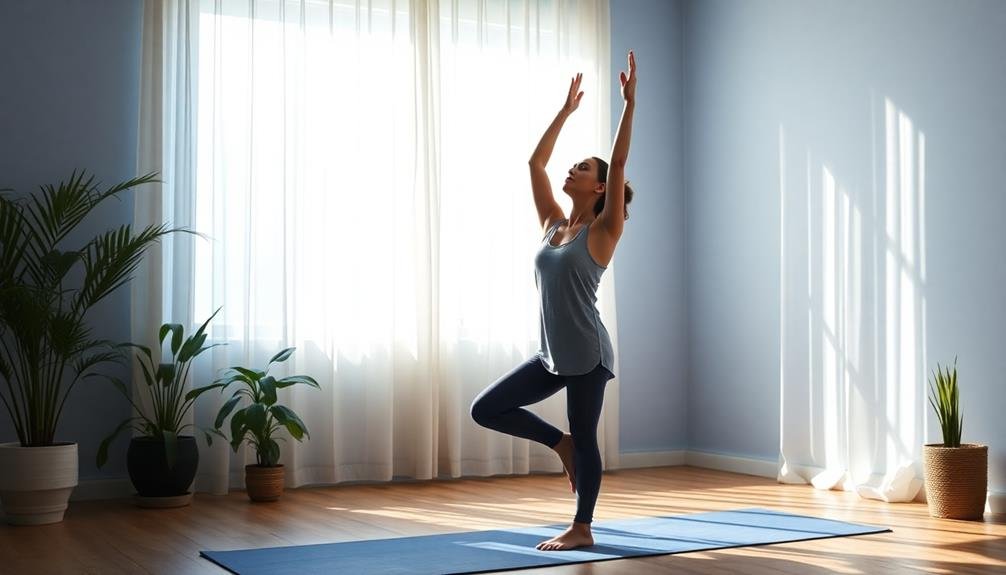
When seeking yoga practices for anxiety relief, you'll find several effective options.
Gentle Hatha yoga can help you ease into mindful movement, while restorative yoga practices encourage deep relaxation and stress reduction.
If you're looking to calm your mind through breath control, consider exploring breathwork-focused yoga styles that emphasize pranayama techniques.
Gentle Hatha Yoga
For those new to yoga or seeking a calming practice, gentle Hatha yoga offers an excellent starting point. This form of yoga emphasizes slow, deliberate movements and controlled breathing, making it ideal for managing anxiety. You'll focus on holding poses for several breaths, allowing your body and mind to relax into each position.
In a typical gentle Hatha class, you can expect:
- A gradual warm-up to prepare your body
- A series of standing and seated poses
- Cool-down stretches and final relaxation
As you practice, you'll learn to connect your breath with your movements, promoting a sense of calm and presence. This mindful approach helps quiet anxious thoughts and brings your attention to the present moment.
You'll also improve flexibility, balance, and strength, which can boost your overall sense of well-being.
Gentle Hatha yoga is particularly beneficial for anxiety because it's not physically demanding. You won't feel pressured to keep up with fast-paced sequences or complex poses. Instead, you'll have time to explore each posture at your own pace, building confidence and body awareness.
This gentle approach allows you to cultivate a sense of calm that extends beyond your yoga practice into daily life.
Restorative Yoga Practices
Restorative yoga often provides the deepest relaxation for those struggling with anxiety. This practice emphasizes passive stretching and long-held poses, allowing your body and mind to fully unwind. You'll use props like blankets, bolsters, and blocks to support your body, enabling you to hold positions for extended periods without strain.
In a restorative yoga session, you'll typically experience fewer poses than in other styles, but you'll stay in each one for 5 to 20 minutes. This extended time allows your nervous system to downshift into a parasympathetic state, promoting feelings of calm and safety. Popular restorative poses include Supported Child's Pose, Legs-Up-the-Wall, and Reclined Bound Angle Pose.
As you practice, focus on your breath and let go of any tension you're holding. You might incorporate gentle breathwork techniques or guided meditation to enhance the calming effects.
Regular restorative yoga can help reduce cortisol levels, improve sleep quality, and increase overall well-being. It's an excellent tool for managing anxiety and depression symptoms, offering a safe space for you to rest, reflect, and recharge.
Breathwork-Focused Yoga Styles
Breathwork-focused yoga styles offer another powerful approach to managing anxiety and depression. These practices emphasize controlled breathing techniques to calm the mind and regulate the nervous system.
You'll find that focusing on your breath can help shift your attention away from anxious thoughts and bring you into the present moment.
One popular breathwork-focused style is Pranayama yoga, which specifically targets breath control. In Pranayama, you'll learn various breathing exercises that can be used both on and off the mat to reduce stress and anxiety.
Another option is Kundalini yoga, which combines dynamic movements with powerful breathing techniques to release emotional blockages and boost energy.
When practicing breathwork-focused yoga, you'll typically:
- Start with simple breath awareness exercises
- Progress to more advanced breathing patterns
- Incorporate breath control into physical postures
Breathwork Techniques for Stress Relief
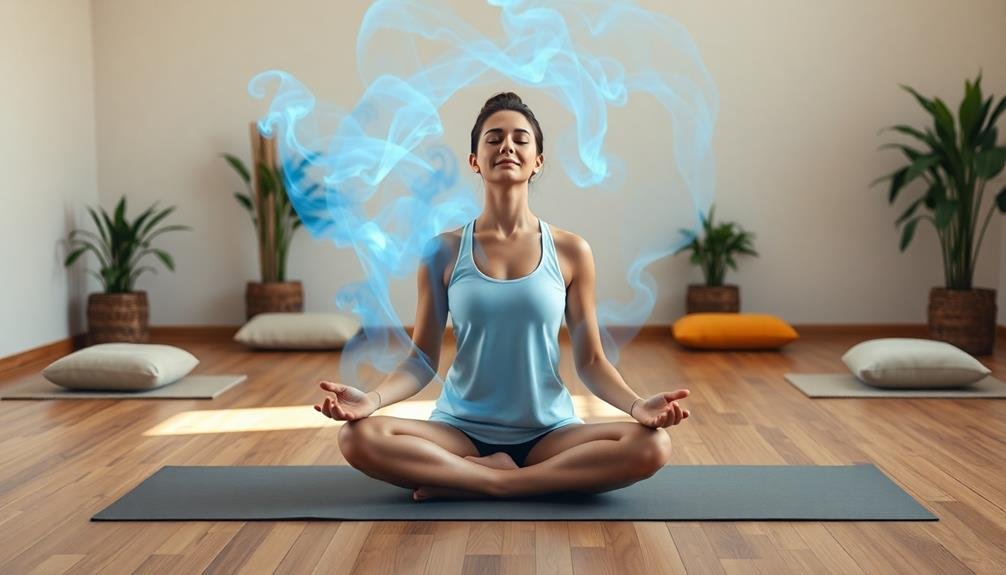
How can something as simple as breathing make a significant impact on your stress levels? The answer lies in the power of intentional breathwork. By controlling your breath, you can regulate your nervous system and reduce anxiety.
One effective technique is diaphragmatic breathing. Place one hand on your chest and the other on your belly. Inhale deeply through your nose, allowing your belly to expand while keeping your chest still. Exhale slowly through your mouth, feeling your belly contract. This method activates your parasympathetic nervous system, promoting relaxation.
Another powerful technique is the 4-7-8 breath. Inhale quietly through your nose for a count of four, hold your breath for seven counts, then exhale forcefully through your mouth for eight counts. Repeat this cycle four times. This practice can help calm your mind and reduce tension in your body.
Box breathing is also effective for stress relief. Inhale for four counts, hold for four, exhale for four, and hold again for four. Visualize tracing a square as you perform this technique. It's particularly useful during acute stress or panic attacks.
Yoga Poses to Combat Depression
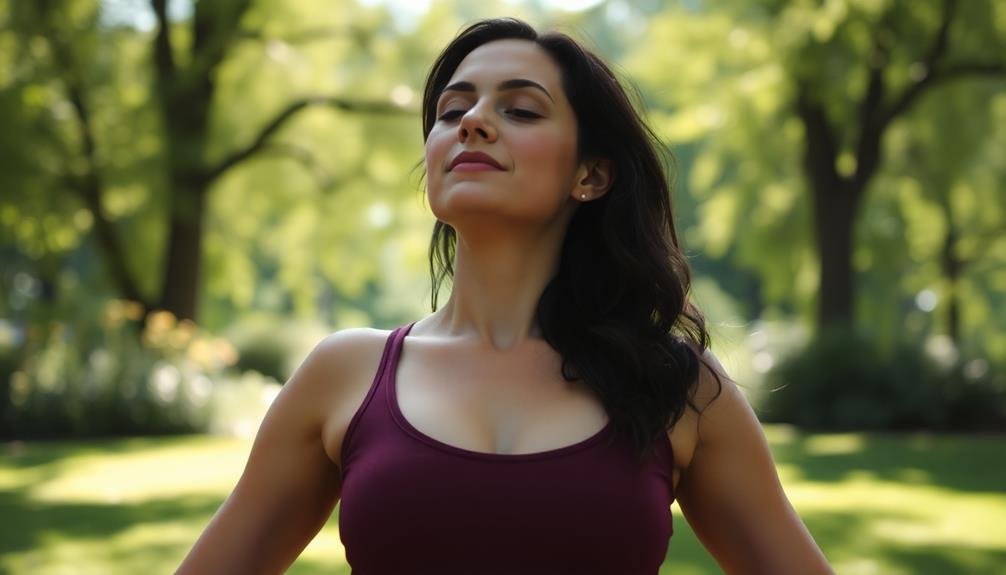
You'll find various yoga poses that can help combat depression, ranging from gentle to energizing to restorative.
If you're new to yoga, start with gentle poses to build confidence and body awareness.
As you progress, you can incorporate more energizing poses to boost energy and restorative poses to promote relaxation and peace of mind.
Gentle Poses for Beginners
Beginners seeking relief from depression can start their yoga journey with gentle, accessible poses. These postures are designed to ease you into the practice, promoting relaxation and mindfulness without overwhelming your body or mind.
Start with the Child's Pose, a restful position that calms your nervous system. Kneel on the floor, sit back on your heels, and stretch your arms forward. Hold this pose for several deep breaths, allowing tension to melt away.
Next, try the Cat-Cow stretch to gently warm up your spine and release stiffness. On your hands and knees, alternate between arching your back (Cow) and rounding it (Cat), synchronizing your breath with each movement.
Finally, practice the Legs-Up-the-Wall pose. This restorative posture helps reduce anxiety and fatigue. Lie on your back with your legs extended up a wall, forming an L-shape with your body.
Remember these key points when practicing:
- Focus on your breath
- Listen to your body and don't push too hard
- Be consistent with your practice
As you become more comfortable, gradually incorporate other poses to expand your routine and deepen your practice.
Energizing Poses for Vitality
After mastering the gentle poses, it's time to explore more invigorating yoga practices that can help combat depression and boost energy. Sun Salutations are an excellent starting point, combining a series of flowing movements that warm up your body and invigorate your mind. Begin with 3-5 rounds, gradually increasing as you build strength and stamina.
Warrior poses are powerful for building confidence and energy. Try Warrior I, II, and III, holding each for 5-10 breaths. These poses strengthen your legs, core, and arms while improving focus and balance.
The Standing Backbend is another energizing pose that opens your chest and stimulates your nervous system. Start slowly, and don't push beyond your limits.
For an immediate energy boost, try Camel Pose. This backbend stretches your entire front body and can help alleviate feelings of sadness or lethargy. Always counter backbends with a forward fold to balance your spine.
Finish your practice with an invigorating breathing exercise like Kapalabhati (Skull Shining Breath) to clear your mind and energize your body. Remember to listen to your body and modify poses as needed.
Restorative Poses for Relaxation
While energizing poses can lift your mood, restorative yoga practices offer a different approach to combating depression. These gentle, supported postures allow your body and mind to relax deeply, reducing stress and promoting a sense of calm.
By holding poses for extended periods, you'll give your nervous system a chance to reset and your thoughts time to settle.
To practice restorative yoga, you'll need props like blankets, bolsters, and blocks to support your body. Start with Child's Pose, using a bolster under your torso for comfort. Next, try Legs-Up-the-Wall pose to improve circulation and ease tension in your lower back. Finally, end with Savasana, or Corpse Pose, to integrate the benefits of your practice.
Restorative yoga offers several benefits for those dealing with depression:
- Reduces physical tension and promotes relaxation
- Calms the mind and reduces racing thoughts
- Improves sleep quality and duration
Mindfulness in Yoga Practice
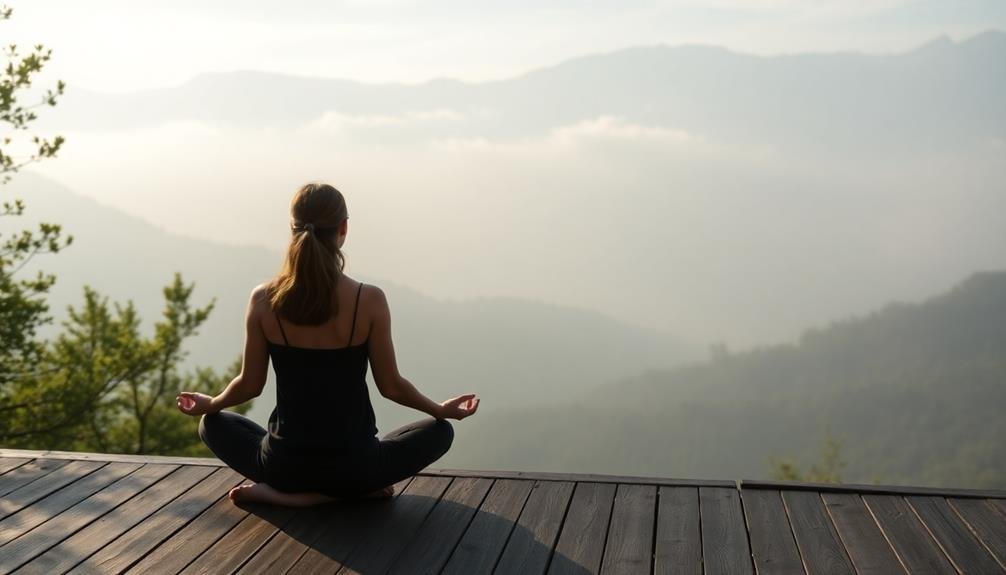
Mindfulness lies at the heart of yoga practice, serving as a powerful tool for managing anxiety and depression. As you engage in your yoga routine, focus on being present in each moment. Pay attention to your breath, the sensations in your body, and the thoughts passing through your mind without judgment.
During poses, observe how your muscles feel as they stretch and contract. Notice the rhythm of your breath and how it changes with different movements. When your mind wanders, gently bring it back to the present. This continuous practice of returning to the now helps train your brain to stay grounded in reality, rather than getting caught up in anxious thoughts or depressive ruminations.
Incorporate mindfulness into your daily life by applying the skills you learn on the mat. When you're feeling overwhelmed, take a few deep breaths and tune into your senses.
What do you see, hear, smell, taste, and feel? This simple exercise can help break the cycle of negative thoughts and bring you back to the present moment, reducing anxiety and improving your overall mood.
Creating a Calming Yoga Routine
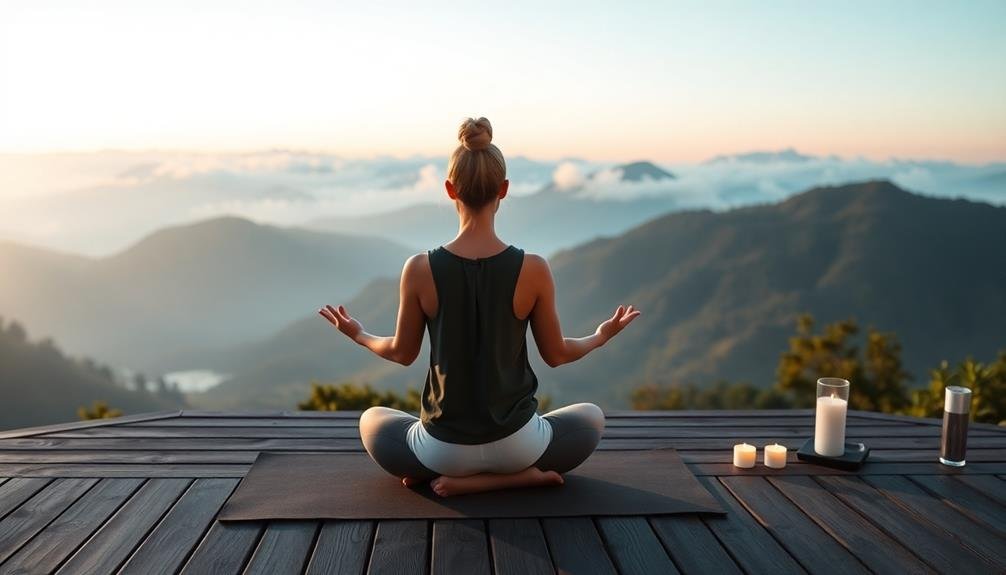
To create a calming yoga routine that addresses anxiety and depression, you'll want to focus on three key elements.
First, select yoga poses that promote relaxation and stress relief, such as gentle forward folds and restorative postures.
Next, set up a peaceful environment with soft lighting, calming scents, and comfortable props to enhance your practice.
Choose Suitable Yoga Poses
Creating a calming yoga routine begins with selecting poses that specifically target anxiety and depression.
You'll want to focus on poses that promote relaxation, grounding, and gentle movement. Start with simple, accessible poses that don't require advanced flexibility or strength.
Consider incorporating these types of poses into your routine:
- Forward bends: These poses calm the nervous system and promote introspection.
- Inversions: Gentle inversions like legs-up-the-wall pose can help shift perspective and reduce stress.
- Restorative poses: Supported poses using props encourage deep relaxation and stress relief.
Don't forget to include breathing exercises and meditation as part of your practice.
Slow, deep breathing can help regulate your nervous system and reduce anxiety symptoms. As you become more comfortable with basic poses, you can gradually introduce more challenging ones.
Set a Peaceful Environment
Once you've selected your poses, it's time to focus on the space where you'll practice. Creating a peaceful environment is essential for maximizing the benefits of your yoga routine. Choose a quiet area in your home or outdoors where you won't be disturbed. Clear the space of clutter and distractions, guaranteeing you have enough room to move freely.
Set the mood with soft lighting, like dimmed lamps or candles. Use soothing scents, such as lavender or sandalwood, to promote relaxation. Contemplate playing calming background music or nature sounds to enhance your practice. Here's a table of elements to reflect on for your yoga space:
| Lighting | Scents | Sounds |
|---|---|---|
| Candles | Lavender | Ocean waves |
| Dimmed lamps | Sandalwood | Soft instrumental |
| Natural light | Sage | Rainforest |
| Salt lamps | Eucalyptus | Singing bowls |
| String lights | Vanilla | Gentle chimes |
Lastly, verify you have all necessary props, such as a yoga mat, blocks, or blankets, within reach. By creating a tranquil environment, you'll set the stage for a more effective and enjoyable yoga practice to help manage anxiety and depression.
Establish Consistent Practice Time
Establishing a consistent practice time is essential for reaping the full benefits of yoga for anxiety and depression. By setting aside dedicated time for your practice, you're creating a routine that your mind and body can rely on. Choose a time of day when you're least likely to be interrupted and can fully focus on your practice. This might be early morning before work, during your lunch break, or in the evening before bed.
To help you stick to your routine, consider these tips:
- Start small: Begin with just 10-15 minutes daily and gradually increase as you build consistency.
- Use reminders: Set alarms or place sticky notes to prompt you to practice at your chosen time.
- Link your practice to an existing habit: For example, practice right after brushing your teeth in the morning.
Consistency is key in managing anxiety and depression through yoga. As you maintain your practice, you'll likely notice improvements in your mood, stress levels, and overall well-being.
Don't be discouraged if you miss a day; simply return to your routine as soon as possible. Remember, the goal is progress, not perfection.
Yoga and Neuroscience Connection
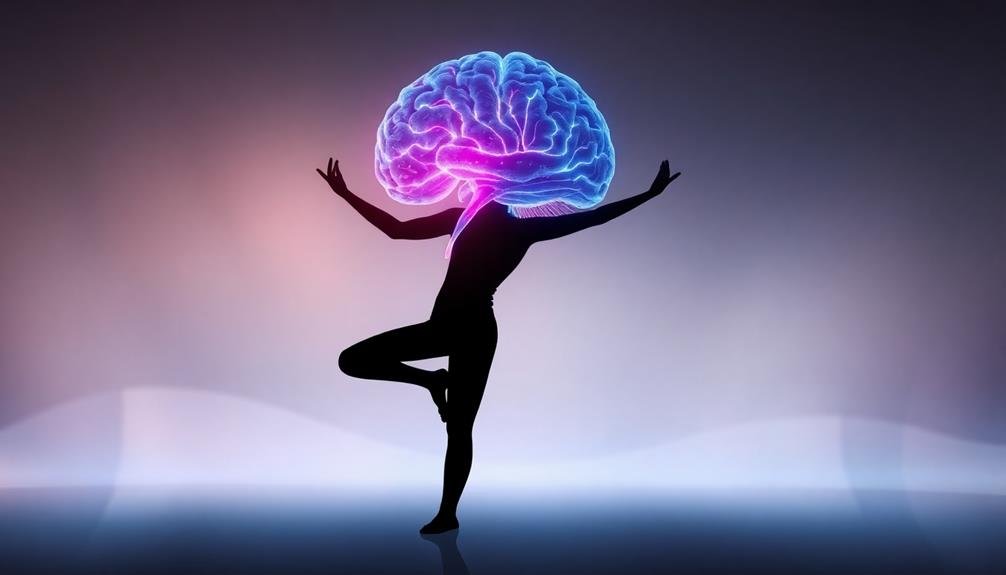
Recent neuroscientific research has revealed three key ways yoga impacts the brain to alleviate anxiety and depression.
First, yoga increases the production of GABA (gamma-aminobutyric acid), a neurotransmitter that promotes relaxation and reduces anxiety. Studies show that practicing yoga for just 60 minutes can boost GABA levels by 27%, providing immediate relief from anxious thoughts.
Second, yoga strengthens the prefrontal cortex, the brain region responsible for emotional regulation and decision-making. As you practice mindfulness during yoga, you're actively training this area, enhancing your ability to manage stress and negative emotions. This improved emotional control can greatly reduce depressive symptoms over time.
Lastly, yoga decreases activity in the amygdala, the brain's fear center. By consistently practicing yoga, you're teaching your brain to respond less intensely to stressors, leading to a calmer overall state. This reduced amygdala reactivity can help break the cycle of anxiety and prevent depressive episodes.
Understanding these neurological benefits can motivate you to maintain a regular yoga practice, knowing that each session is actively rewiring your brain for better mental health.
Integrating Meditation With Yoga
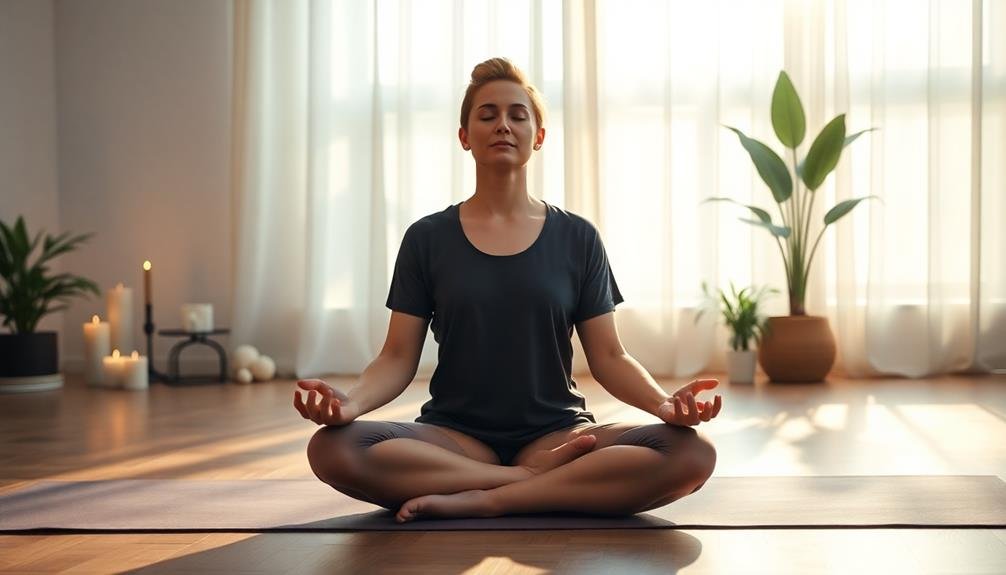
While yoga itself offers significant mental health benefits, combining it with meditation can amplify these effects. You'll find that integrating meditation into your yoga practice creates a powerful synergy, enhancing your ability to manage anxiety and depression.
By incorporating mindfulness techniques during your yoga sessions, you're training your mind to stay present and focused, reducing rumination and worry.
To effectively combine meditation with yoga, try these approaches:
- Begin your practice with a short meditation
- Incorporate mindful breathing throughout your poses
- End your session with a longer meditation or guided relaxation
As you integrate meditation into your yoga routine, you'll develop greater self-awareness and emotional regulation skills.
You'll learn to observe your thoughts and feelings without judgment, allowing you to respond to stressors more effectively. This combined approach can help rewire your brain's stress response, leading to long-term improvements in your mental health.
Yoga for Emotional Balance
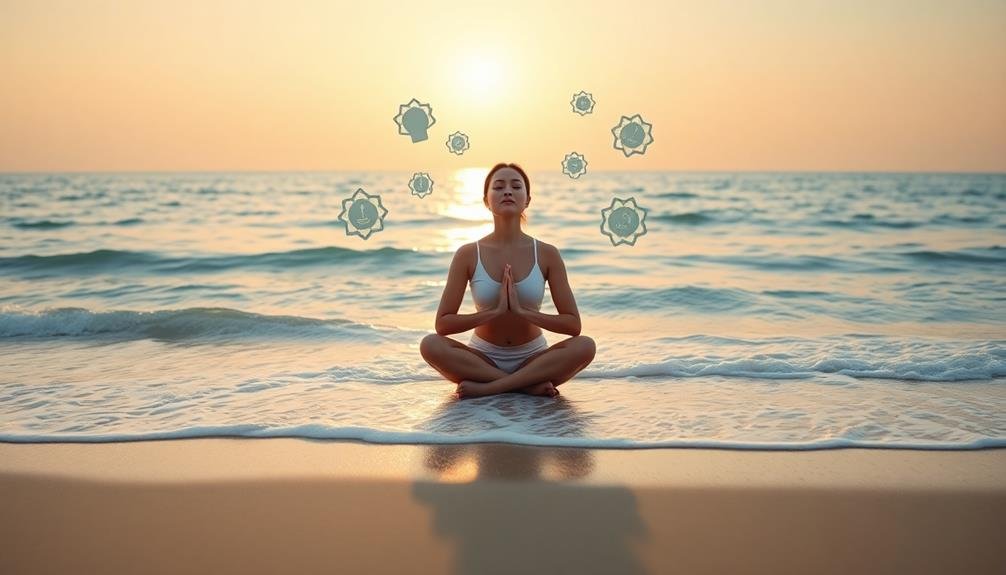
Emotional balance is a cornerstone of mental well-being, and yoga can be a powerful tool to achieve it. By practicing specific poses and breathwork, you'll learn to regulate your emotions and respond to stress more effectively. Focus on poses that open your heart and chest, as these can help alleviate feelings of anxiety and depression.
Incorporate the following poses into your routine for emotional balance:
| Pose | Benefits | Duration |
|---|---|---|
| Child's Pose | Calms mind, relieves tension | 1-3 minutes |
| Cat-Cow | Improves mood, releases spine | 5-10 rounds |
| Warrior II | Builds confidence, focus | 30-60 seconds per side |
| Bridge Pose | Reduces anxiety, opens chest | 30-60 seconds |
| Legs-Up-the-Wall | Relieves stress, promotes relaxation | 5-10 minutes |
Remember to breathe deeply and mindfully throughout your practice. You'll find that regular yoga sessions can help you develop greater emotional resilience and self-awareness. Don't be discouraged if you don't see immediate results; emotional balance is a skill that develops over time with consistent practice. As you continue your yoga journey, you'll likely notice improvements in your overall mood and ability to handle life's challenges.
Building Resilience Through Yoga
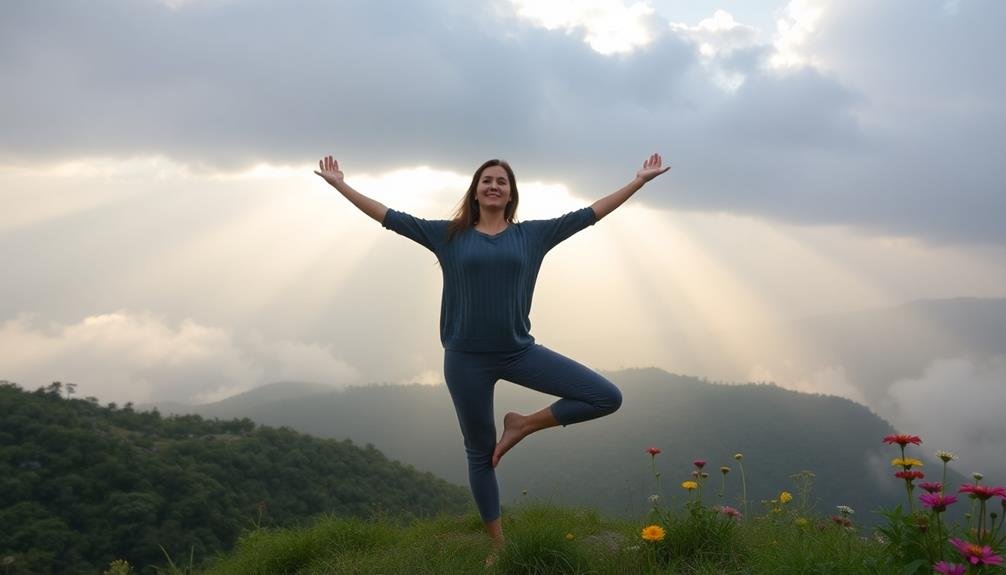
Building resilience is a key benefit of regular yoga practice. As you engage in yoga, you're not just stretching your body; you're also strengthening your mind's ability to cope with stress and adversity. Through consistent practice, you'll develop a greater sense of inner calm and emotional stability, which can help you bounce back from life's challenges more easily.
Yoga builds resilience by:
- Enhancing self-awareness
- Improving emotional regulation
- Fostering a growth mindset
By focusing on your breath and bodily sensations during yoga, you'll become more attuned to your thoughts and emotions. This heightened self-awareness allows you to recognize stress triggers and respond to them more effectively.
You'll also learn to regulate your emotions better, using techniques like deep breathing and mindfulness to stay calm in difficult situations.
Moreover, yoga encourages a growth mindset by teaching you to approach challenges with curiosity and persistence. As you progress in your practice, you'll gain confidence in your ability to overcome obstacles, both on and off the mat.
This newfound resilience will serve you well in all aspects of life, helping you navigate anxiety, depression, and other mental health challenges with greater ease and grace.
Yoga's Role in Therapy
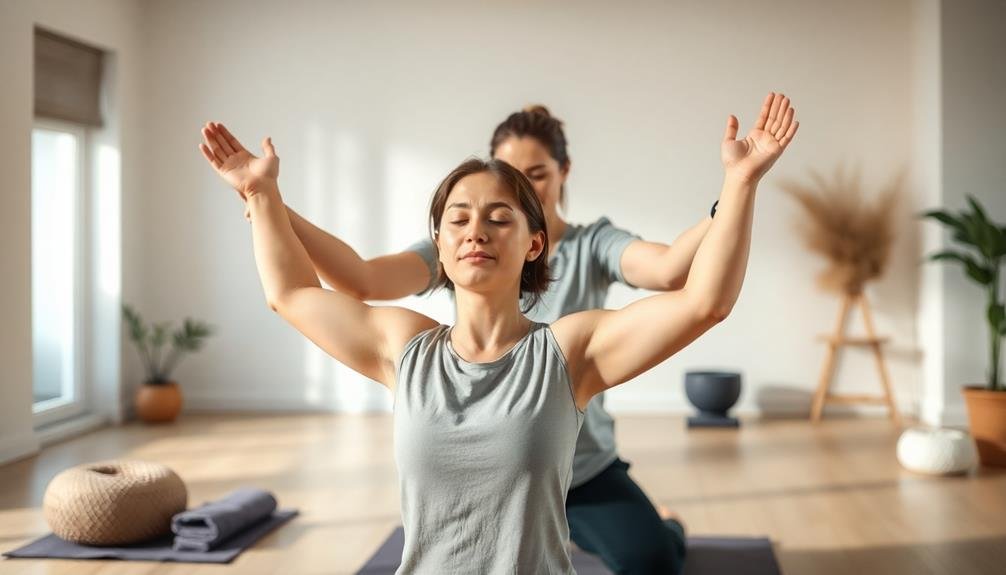
Yoga has increasingly become an integral part of mental health therapy. As a complementary approach, it's being integrated into treatment plans for anxiety and depression. You'll find that many therapists now recommend yoga as part of a holistic treatment strategy.
In therapy sessions, you might experience guided yoga practices tailored to your specific needs. These can include gentle postures, breathing exercises, and meditation techniques designed to reduce stress and improve mood. Your therapist may teach you simple yoga moves you can practice at home, empowering you to manage symptoms between sessions.
Yoga's role in therapy extends beyond physical postures. It's used to enhance mindfulness, helping you become more aware of your thoughts and emotions. This awareness can be essential in cognitive behavioral therapy, allowing you to identify and challenge negative thought patterns.
You'll also find that yoga can improve your body-mind connection, which is often disrupted in anxiety and depression. By focusing on physical sensations during yoga, you're learning to stay present and grounded, skills that can help manage overwhelming emotions in daily life.
Frequently Asked Questions
How Long Does It Take to See Mental Health Benefits From Yoga?
You'll likely notice mental health improvements within a few weeks of regular yoga practice. However, you may experience immediate mood boosts after individual sessions. Consistency is key, so aim for at least 2-3 sessions per week for best results.
Can Yoga Replace Traditional Medication for Anxiety and Depression?
While yoga can be beneficial, it shouldn't replace traditional medication for anxiety and depression without consulting your doctor. You'll find it's often most effective when used alongside prescribed treatments, complementing your overall mental health strategy.
Are There Any Potential Risks or Side Effects of Practicing Yoga?
While yoga's generally safe, you'll want to be cautious. You might experience muscle strains, joint injuries, or dizziness if you push too hard. Always listen to your body, start slowly, and consult a doctor if you have pre-existing conditions.
What's the Best Time of Day to Practice Yoga for Mental Health?
You'll benefit most by practicing yoga when you're most consistent. Morning routines can set a positive tone for your day, while evening sessions help you unwind. Listen to your body and choose a time that fits your schedule best.
How Often Should One Practice Yoga to Manage Anxiety and Depression Effectively?
You'll benefit most by practicing yoga 3-5 times a week for managing anxiety and depression. Start with shorter sessions and gradually increase duration. Consistency is key, so find a routine that fits your schedule and stick to it.
In Summary
You've learned how yoga can be a powerful tool for managing anxiety and depression. By incorporating mindful practices, breathwork, and specific poses into your routine, you're taking active steps toward emotional balance and resilience. Remember, yoga isn't just about physical flexibility—it's about mental flexibility too. As you continue your journey, don't hesitate to integrate yoga with other therapeutic approaches. You're on the path to a calmer, more centered you.





Leave a Reply